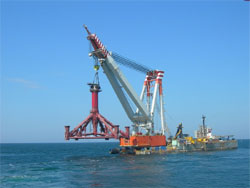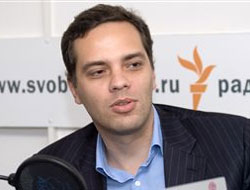Wanted: Russian resolve on oil strategy
on
Wanted: Russian resolve on oil strategy
To retain its oil production levels, Russia will need to make substantial changes in its oil policies and oil industry. Current production areas will have to be modernised and large investments will have to be made in new production areas in faraway places. Foreign and domestic private investments and technology seem indispensable to make this happen, but Russia has chased away private investors with heavy taxes and nationalisations. Now the Russian government has to make up its mind: will it allow the market to work – or will it take oil production into its own hands? As one expert puts it: ‘We need clarity. We can’t have this mixed policy which is leading us nowhere.’
 |
| Construction of a platform at Lukoil's Yuri Karchagin field in the Caspian |
The Russian government has divided the period to 2030 in three shorter periods. The first one deals with the after-effects of the global economic crisis and lasts until 2013-2015. In the second period – which will probably last until 2020-2022 – the Russian economy has to be diversified and Russia needs to catch up with the world’s most efficient and innovative economies. The period until 2030 is seen as one of further development.
For the whole period until 2030, the new energy strategy foresees a growth of Russian oil production from the current 10 million barrels per day (bpd) to 11 million. Although this is an increase of a mere 10% - in the last decade oil production grew by 50% - this will represent an enormous challenge to the Russian oil sector. Much of the current production comes from so-called brown fields that have been producing for a long time and are headed for the end of their lifecycle. Moreover the industry has been badly hit by recent oil price declines and the economic recession, which has hampered access to new capital. Unlike the international oil companies, Russian oil companies – many of which are controlled by the state – have difficulty realising their planned investments.
As a result – as the new energy strategy notes – in 2009 only 60% of planned investments were realised in the energy sector. (The strategy does not give separate figures for the oil and gas sectors.) In addition, 80% of the currently used capital assets in the oil sector has been depreciated. This is hardly surprising as much of the production assets and infrastructure stems from Soviet times. And although investments have increased substantially in recent years, the lack of investments in the 1990s is now increasingly being felt. The Russians themselves are well aware of this. They regard the high share of (very) old production assets as a direct threat to their energy security.
Enough oil
In short, investments in new production capacity are extremely urgent. Four questions present themselves: how much money is needed? Who is to supply this money? How much oil does Russia really have? And where is this oil located?
According to the new energy strategy, $600 billion of investments will be needed in the oil industry until 2030 (in 2007 prices). The strategy assumes that investments needed in exploration and production (E&P) will amount to some $110 billion in the period to 2016, another $110 billion in the period 2016-2022 and then around $275 billion in the period 2022-2030. The bulk of this investment, around 70%, must go to East Siberia and the far east (Sakhalin). It may be noted that Leonid Fedun, Vice-President of Lukoil, Russia’s largest privave oil company, told the Wall Street Journal in 2008 that he thought the Russian oil sector needed $1,000 billion in investments for the next 20 years to merely retain production level at 10 million bpd.
Shamil Yenikeyeff, research fellow at the Oxford Institute of Energy Studies and author of the forthcoming book The Battle for Russian Oil (Oxford University Press, 2010), thinks that the government’s investment figures are probably not too far off from what will actually be needed: ‘They are usually pretty accurate in their forecasts.’ Yenikeyeff expects that the existing production capacity in Russia can produce about 70% of the targeted production, i.e. some 7 million bpd in the coming 5 to 10 years. The shortfall of 3 to 4 million bpd can be made up with relatively limited investments in additional capacity, e.g. from the Vankor field in Eastern Siberia, initial production from the Caspian Sea, expansion of production in Timan Pechora in northern Russia and additional small fields and enhanced oil recovery in West Siberia and the Volga Urals. However, beyond that period, production from existing fields will decline dramatically, says Yenikeyeff, and large new investments will be needed to maintain or grow production levels.
Another way of looking at the capacity situation is to calculate how much oil needs to be on stream (i.e. reserves capable of being produced) for Russia to be able to keep producing. Russia will need to produce about 77 billion barrels of oil until 2030 if it is to increase its production from 10 to 11 million bpd. At this moment, at a rough estimate some 30 billion barrels are probably on stream.
According to the government’s energy strategy, the $600 billion of investments will unlock 91.5 billion barrels of new production capacity in the period up to 2030. This will be done in three stages, in the following regions:
Oil development until 2030 in million tonnes (billion barrels)
*The total figure includes Sakhalin, Volga/Urals and the Caspian
| stage 1 | stage 2 | stage 3 | |
| West Siberia | 1205 (8.8) | 2500 (18.3) | 2500 (18.3) |
| East Siberia | 165 (1.2) | 1200 (8.8) | 1200 (8.8) |
| European North | 91 (0.66) | 330 (2.4) | 200 (1.5) |
| Total* | 1854 (13.5) | 5597 (41) | 5122 (37 |
If all goes according to plan, then, Russia will have brought over 120 billion barrels on stream by 2030 (new plus existing capacity), of which some 77 billion will have been produced. That leaves over 40 billion barrels still to be produced – but these reserves are of course needed to keep up production in the period after 2030.
Is there actually that much oil? According to BP’s Annual Statistical Review, one of the most authoritative sources of global oil statistics, total proven Russian oil reserves amount to only 79 billion barrels. But these are proven reserves, they don’t include reserves that have yet to be developed. Yenikeyeff thinks that the availability of oil reserves is not a problem. ‘There is enough oil. As in the rest of the world it is more about cheap oil. The new fields in Russia are much more costly to exploit than the older ones due to the fact that they need to be developed under much more challenging geological and climatic conditions and are often located at large distances of existing infrastructure’.
Although Yenikeyeff does not think Russia should encounter much difficulty reaching the production levels mentioned in the Strategy, at least as far as available reserves are concerned, he does see a crucial tipping point in Russian oil production between 2015 and 2020 that Russia needs to overcome. ‘Over the next few years production will probably rise slightly. However, as current production fields will start to lose production capacity and investments in E&P have been fairly low in the past years, production is set to decline in the medium term. It will very much depend on the sums that are being invested over the next couple of years whether they will be able to reverse that downward trend and are able to reach the 11 million bpd in 2030.’
Taxation
The availability of money, however, will be a much bigger issue. ‘To get the necessary funding for these investments could prove to be a big problem’, says Yenikeyeff, who sees high taxes as a particularly large barrier to investment. ‘Over the past eight years, gross revenue of oil sales in Russia was around $1 trillion. However, $700 billion of this money went straight into the state’s coffers and only $150 billion could be accounted for as net income for the oil companies. Out of this $150 billion only some $50-70 billion was re-invested in the oil sector. Between 2003 and 2005 the share of taxes per barrel of oil increased from 35% to 60%.’
The reason behind the tax increases, says Yenikeyeff, was the wish of the Russian government to diversify the economy away from the oil and gas sector. However, he notes that over the years the share of the oil industry in the country’s GDP has only increased. ‘So now they have failed to diversify and have budget deficits at the same time. The sector has only gained importance, so they cannot afford to fail in attracting investment.’
So far, these adverse investment conditions have, according to Yenikeyeff, had a very negative effect on the behaviour of domestic investors. ‘Domestic oil companies have proven more keen to acquire foreign assets and to invest in oil projects abroad than to invest in exploration and production in Russia. In 2008 total outflow of capital from Russia was $130 billion, of which roughly $60 billion came from the banking sector. The other $70 billion came from the rest of the companies and a substantial part of that money was from the energy sector.’
According to Yenikeyeff, investments in E&P over the next five years will give a good indication of whether Russia will reach the targets that are put forward in the new strategy. But he stresses that the government will have to make investors much happier. ‘The days of the government dictating the terms for investment are now over’. In order to keep oil production at current levels – and hence secure the state budget – the companies have to attract foreign investment.
This money – whether it will come from China, the US or Europe – will only be made available if certain conditions are met. ‘There is no doubt huge interest from foreign companies. 80% of the world’s oil reserves are controlled by state-owned companies, so the international private oil companies are always on the lookout for investment opportunities. But proper legal mechanisms are needed under which investments are well protected, also in case of amendments to the tax structures. The government will have to provide a stimulus to investment.’
Tremendous risk
The well-known independent Russian energy expert Vladimir Milov, who was Russian deputy minister of energy for a brief period in 2002 and now runs his own think tank, the Institute of Energy Policy, agrees that the current investment climate scares off foreign investors. He tells an anecdote about it. ‘About three years ago, in December 2006, when it was announced that Shell was selling its control in Sakhalin II to Gazprom, I spoke with one of the top managers of one of the major international oil companies operating in Russia today. He said that after all he had seen taking place with Sakhalin II, they would not consider investments in the amount of more than one billion dollars in Russia. Otherwise the risk exposure would be too large, which they could not afford.’
Milov mentions this example to show that, in his view, conditions in Russia are currently not conducive to private investments. He says that private investors still run the risk of losing their investment and have their assets expropriated. ‘What has become clear is that the Yukos case was not the exception to the rule. We have seen more examples like that, such as Sakhalin II and Russneft and many others. So the point is that any kind of private investment in Russian oil production is exposed to tremendous risk’.
|
Top Russian oil producers
Additional crude oil and gas condensate production comes from Gazprom, Novatek, some smaller players and from companies that produce under Production Sharing Agreement terms (Sakhalin Energy, Exxon Neftegas and Total). |
‘We really have a major need for investments’, Milov points out. ‘In exploration in the first place and of course also in the development of new fields, which will prove to be much more difficult to develop than was the case in previous years. But for this, we need good investment mechanisms. Now, if you want to let investments be controlled centrally, by the national champions, I am against that approach, but if you want that, then do it, and make sure it works. But frankly I don’t see anybody doing this. No one is cutting the Gordian knot. That’s the problem. We need clarity on which investment mechanism will be used. We can’t have this frustrating mixed policy which is leading us nowhere.’
Flirting
Although some observers have lately noticed a change in attitude on the part of the Russian government towards foreign investors in the Russian oil sector, Milov is rather sceptical about this. ‘I don’t really see it. I hear a lot of rumours. I see a lot of flirting on the part of government, with private investors. There is a lot of ritual dancing. I think right now, the Russian government is just doing what they please. This may change if they will start to face significant problems. But I don’t think we are quite there yet’.
 |
| Vladimir Milov |
But Milov does not believe Russia will open up quickly to foreign investment at the present time. ‘I think they will now pursue the Lukashenko strategy. Alexander Lukashenko [President of Belarus] is flirting right now with the idea of privatisation to support government revenues. But apart from all his rhetoric, what he is doing in reality is that he is just trying to sell to investors some minor equity stakes in some really low liquidity companies - fairly uninteresting, bad assets, for really a lot of money. I think this would also be the first move of the Russian government in this environment, if they are really thinking about opening the oil industry to private capital and foreign investment. But I don’t think the current government will act decisively in this if they don’t receive some major warning signals that things are just not OK anymore. If we were hit by a significant decline in oil output, then we might talk about some serious change in policies.’
Geographical picture
Then there is also the interesting question of where in Russia oil money can best be invested. According to Milov, the government’s strategy puts too much emphasis on the wrong production regions. He stresses that Russia still has oil reserves of more than twice its proven estimates (what he calls the conservative Western estimates). ‘International auditing firms like DeGolyer and MacNaughton or Miller and Lents almost unanimously estimate the reserves of Russia somewhere between 150 and 200 billion barrels. This pretty much corresponds with the estimates of the majority of our geologists.’
However, he points out that if it were up to the private sector where to invest, then the geographical picture of the energy strategy would very likely look totally different. Milov believes that most of the potential of Russia still lies in West Siberia and furthermore in the northern Timan Pechora region and the North Caspian, He thinks that the prospects of East Siberia as Russia’s new oil province are heavily overestimated. ‘Why so much noise about Eastern Siberia as a prospective region? It is quite difficult to produce oil out there and after all there is not so much oil there’.
Milov points out that the reserves of East Siberia only amount to some 5 billion barrels and that, although he is sure more oil will be found in the region, ultimately prospects are quite limited. ‘As we can see, Lukoil, currently the country’s largest private oil company, is not working in East Siberia. This is not by accident. Obviously, people know there is much more potential in new prospective regions in the western part of the country rather than in East Siberia’.
Milov recalls that Yukos was the early mover in East Siberia, but he notes, ‘I have to say – I have observed the way it was done in the early 2000s, when Yukos was still powerful [Yukos then was Russia’s largest oil company and was privately owned] – they did really proceed very carefully. And they had understood all the risks and the extra costs of development of East Siberian oil fields like Vankor and the fields in Yakutia. And believe me, I am convinced that Yukos would have never taken any adventuristic steps in this direction. They would only develop these greenfields if they had a good commercial potential. This was also linked with their vision of how to design a pipeline strategy for the development of eastern Siberia. I believe Yukos would have contained any kind of effort to build an extra costly pipeline for transportation of Eastern Siberian oil, which would really not have been economic. And I remember that Yukos’ main goal – when they had promoted the idea of the construction of the pipeline to Daqing (China) – was to keep costs of construction and future operating costs at a reasonably low level. I think they would not have engaged themselves in this kind of adventure like ESPO, the East Siberia Pacific Oil pipeline.’ (A pipeline system built by state-owned Transneft to transport oil from East Siberia to China, Japan and other Asia Pacific markets.)
As to the oil potential of the arctic offshore and Sakhalin offshore, Milov believes that too is overestimated. ‘These plays will mostly be about gas.’
 |
| Map of producing and prospective oil regions in Russia. Source: Energy Information Administration. Please click on the map to view a large PDF version of the map. |


Discussion (0 comments)